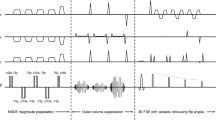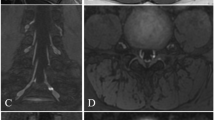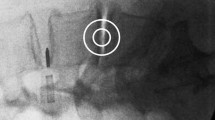Abstract
Objectives
Technical assessment of SHINKEI pulse sequence and conventional 3DIRTSE for LS plexus MR neurography.
Methods
Twenty-one MR neurography examinations of the LS plexus were performed at 3 T, using 1.5-mm isotropic 3DIRTSE and SHINKEI sequences. Images were evaluated for motion and pulsation artefacts, nerve signal-to-noise ratio, contrast-to-noise ratio, nerve-to-fat ratio, muscle-to-fat ratio, fat suppression homogeneity and depiction of LS plexus branches. Paired Student t test was used to assess differences in nerve conspicuity (p < 0.05 was considered statistically significant). ICC correlation was obtained for intraobserver performance.
Results
Four examinations were excluded due to prior spine surgery. Bowel motion artefacts, pulsation artefacts, heterogeneous fat saturation and patient motion were seen in 16/17, 0/17, 17/17, 2/17 on 3DIRTSE and 0/17, 0/17, 0/17, 1/17 on SHINKEI. SHINKEI performed better (p < 0.01) for nerve signal-to-noise, contrast-to-noise, nerve-to-fat and muscle-to-fat ratios. 3DIRTSE and SHINKEI showed all LS plexus nerve roots, sciatic and femoral nerves. Smaller branches including obturator, lateral femoral cutaneous and iliohypogastric nerves were seen in 10/17, 5/17, 1/17 on 3DIRTSE and 17/17, 16/17, 7/17 on SHINKEI. Intraobserver reliability was excellent.
Conclusion
SHINKEI MRN demonstrates homogeneous and superior fat suppression with increased nerve signal- and contrast-to-noise ratios resulting in better conspicuity of smaller LS plexus branches.
Key Points
• SHINKEI provides homogeneous and superior fat suppression, shown by higher nerve and muscle-to-fat ratios.
• SHINKEI shows better nerve signal-to-noise and contrast-to-noise ratios than 3DIRTSE.
• SHINKEI enables nerve-selective images with increased conspicuity of smaller LS plexus branches.
• SHINKEI should be considered in routine MR neurography of the LS plexus.






Similar content being viewed by others
Abbreviations
- 3DIRTSE:
-
three-dimensional inversion recovery turbo spin echo
- DWI:
-
diffusion-weighted imaging
- iMSDE:
-
improved Motion Sensitized Driven Equilibrium
- SHINKEI:
-
nerve-SHeath signal increased with INKed rest-tissue RARE Imaging
References
Kuntz C 4th, Blake L, Britz G et al (1996) Magnetic resonance neurography of peripheral nerve lesions in the lower extremity. Neurosurgery 39:750–756
Filler AG, Kliot M, Howe FA et al (1996) Application of magnetic resonance neurography in the evaluation of patients with peripheral nerve pathology. J Neurosurg 85:299–309
Filler AG, Maravilla KR, Tsuruda JS (2004) MR neurography and muscle MR imaging for image diagnosis of disorders affecting the peripheral nerves and musculature. Neurol Clin 22:643–682, vi–vii
Viallon M, Vargas MI, Jlassi H, Lovblad KO, Delavelle J (2008) High-resolution and functional magnetic resonance imaging of the brachial plexus using an isotropic 3D T2 STIR (Short Term Inversion Recovery) SPACE sequence and diffusion tensor imaging. Eur Radiol 18:1018–1023
Vargas MI, Viallon M, Nguyen D, Beaulieu JY, Delavelle J, Becker M (2010) New approaches in imaging of the brachial plexus. Eur J Radiol 74:403–410
Chhabra A, Thawait GK, Soldatos T et al (2013) High-resolution 3 T MR neurography of the brachial plexus and its branches, with emphasis on 3D imaging. AJNR Am J Neuroradiol 34:486–497
Chhabra A, Zhao L, Carrino JA et al (2013) MR neurography: advances. Radiol Res Pract 2013:809568
Eppenberger P, Andreisek G, Chhabra A (2014) Magnetic resonance neurography: diffusion tensor imaging and future directions. Neuroimaging Clin N Am 24:245–256
Zhao L, Wang G, Yang L, Wu L, Lin X, Chhabra A (2013) Diffusion-weighted MR neurography of extremity nerves with unidirectional motion-probing gradients at 3 T: feasibility study. AJR Am J Roentgenol 200:1106–1114
Yoneyama M, Takahara T, Kwee TC, Nakamura M, Tabuchi T (2013) Rapid high resolution MR neurography with a diffusion-weighted pre-pulse. Magn Reson Med Sci 12:111–119
Acknowledgements
Thanks to Yoneyama M, Masaya Takahashi, Dwayne Isbell and Ivan Dimitrov for the MRI sequence support. The scientific guarantor of this publication is Avneesh Chhabra. The authors of this manuscript declare relationships with the following companies: Dr. Chhabra has received research grants from GE-AUR (GERRAF), Siemens Medical Solutions and Integra Life Sciences. He also serves as a research consultant with Siemens CAD group. One of the authors has significant statistical expertise. Institutional review board approval was obtained. Written informed consent was waived by the institutional review board. Methodology: retrospective, diagnostic or prognostic study, performed at one institution.
Dr Chhabra has received research grants from GE-AUR (GERRAF), Siemens Medical Solutions, and Integra Life Sciences. He also serves as a research consultant with Siemens CAD group.
Author information
Authors and Affiliations
Corresponding author
Electronic supplementary material
Below is the link to the electronic supplementary material.
3DIRTSE of LS plexus (MPG 1530 kb)
3D SHINKEI MPR of LS plexus (MPG 1814 kb)
3D SHINKEI MIP of LS plexus (MPG 1764 kb)
Rights and permissions
About this article
Cite this article
Kasper, J.M., Wadhwa, V., Scott, K.M. et al. SHINKEI—a novel 3D isotropic MR neurography technique: technical advantages over 3DIRTSE-based imaging. Eur Radiol 25, 1672–1677 (2015). https://doi.org/10.1007/s00330-014-3552-8
Received:
Revised:
Accepted:
Published:
Issue Date:
DOI: https://doi.org/10.1007/s00330-014-3552-8




